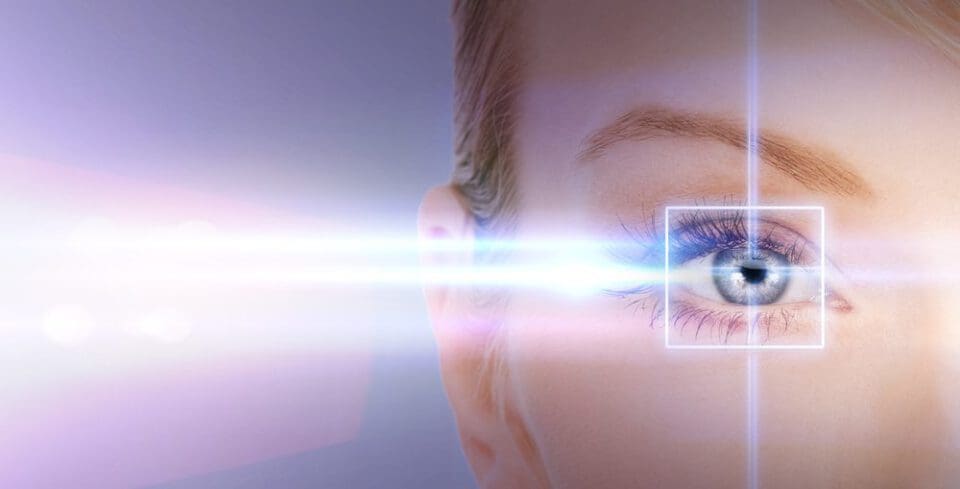
Medically Reviewed by Angelique J. Pillar, M.D. NVISION Surgeon
Guide to Laser Eye Surgery in 2024 (Types, Costs, & More)
Home /
Last Updated:

Medically Reviewed by Angelique J. Pillar, M.D. NVISION Surgeon
Laser eye surgery is a surgical procedure that can treat a number of conditions that make it difficult for people to see clearly.
Not everyone can get laser eye surgery. People with certain medical conditions, or those who have specific lifestyles or environmental factors, might not qualify for the surgery.
Table of Contents
As with any kind of medical procedure, there are risks associated with laser eye surgery. They are mostly mildly to moderately inconvenient, and they will resolve with appropriate care and the passage of time.
In most cases, laser eye surgery involves a surgeon or a laser cutting a very fine flap on the surface of the corner, lifting the flap, and then using a laser to adjust the eye so light waves are properly focused on the retina. Though you can see following surgery, full recovery usually takes two or three weeks.
Preparing for laser eye surgery involves talking with an eye surgeon about what kind of procedure they think will best improve your vision, how much it will cost, and what kind of follow-up care is required

How Can Laser Eye Surgery Help?
There are a number of vision conditions that can be treated with refractive surgery. Examples include:
- Nearsightedness, also known as myopia. People with myopia have eyeballs that are a little longer than a normal eye. This means that the eye has too much refractive power for its length, so light is brought into focus before it reaches the retina. This makes faraway objects look unclear because the light is not focused on the retina, as it should be. Nearly 70 million people in the United States have some amount of myopic vision.
- Farsightedness, or hyperopia. This is very similar to myopia, except that the focal point of light rays is behind the retina. This makes close objects appear blurry.
- Astigmatism. This is a condition where the curvature of the cornea is uneven, making images appear distorted and objects at any distance look unclear. These vision problems are more pronounced in dark conditions and when lights are bright (as with nighttime driving).
- Presbyopia. This tends to occur in people who are over the age of 40. It is not a disease, but a natural changing of the structure of the eyeball due to age. In youth, the lens behind the iris is soft and flexible, changing shape as needed to focus light rays onto the retina. As a person gets older, the lens loses its flexibility, making it harder to read or carry out certain precision, up-close tasks (like threading a needle). Presbyopia has no cure, but it can be corrected with refractive surgery.
You deserve clear vision. We can help.
With 135+ locations and over 2.5 million procedures performed, our board-certified eye surgeons deliver results you can trust.
Your journey to better vision starts here.
Who Should Get Laser Eye Surgery?

Mayo Clinic writes that the procedure is best suited for people who have only a moderate degree of refractive distortions to their vision and otherwise do not have significant problems with their sight.
Well before the surgery, a doctor will ask detailed questions about the patient’s eye health and perform an evaluation on the eyes to make sure there are no unknown conditions that might complicate the process. Such conditions would include:
- Some form of eye disease that causes progressive deterioration of vision and thinning of the cornea (known as keratoconus). Even if the patient does not have keratoconus but has a family history of the condition, this might render them ineligible to receive refractive surgery.
- Conditions such as keratitis, uveitis, herpes simplex affecting the eyes, and other infections of the eyes.
- Injuries to the eye or eyelid disorders.
- Chronically dry eyes. Eye surgery can exacerbate this condition.
- Large pupils. This might disqualify people from laser eye surgery, particularly if they have large pupils in dim light. The operation might leave them with glare, halos and ghost images in their vision.
- Glaucoma and cataracts.
Additionally, laser eye surgery can be risky for people who have severe refractory errors. In essence, their vision is too deteriorated for surgery to adequately correct. On the other end of the spectrum, people who have good overall vision will not stand to receive any significant benefits from the process, and they might similarly be disqualified from the procedure.
Patients who are active participants in contact sports, such as football, wrestling or boxing, and who have a high risk of their face and eyes being impacted as a result of the sport, might not be good candidates for this kind of surgery.

LASIK Eye Surgery
LASIK—short for Laser-Assisted-In-Situ Keratomileusis—is the most commonly performed laser eye procedure in the world. It’s one of the safest and most effective ways to correct vision, and NVISION® surgeons are leaders in the LASIK field. NVISION® Eye Centers offer Custom LASIK, a procedure more customized to your individual eyes.
Conditions Affecting Surgery Eligibility
Part of the evaluation process will also cover the doctor asking general questions about health and lifestyle. There are medical conditions, unrelated to the eyes or vision, that can increase the normal risks associated with laser eye surgery.
- Any weaknesses to the immune system: These could be the result of a disease or condition that impairs the body’s ability to heal itself or that makes the body more prone to infections. Such conditions can include HIV, lupus, rheumatoid arthritis, and various other autoimmune disorders. This also includes the consumption of immunosuppressive medications.
- Diabetes: Patients with diabetes who experience retinopathy (a diabetic complication that affects the eyes) will not have their vision improved with laser eye surgery, and doctors will refuse to prescribe this form of treatment. Additionally, people who have diabetes may heal at a slower rate than others, so the cornea can take longer to recover. Lastly, the fluctuating blood sugar levels of diabetes can mean frequent changes to prescription medication, which can result in the vision treatment having too low an accuracy (and a chance of success) for it to be prescribed.
- Depression and certain pain conditions: Since both can lead to dry eyes and a higher risk of post-surgical pain, these conditions may disqualify someone from laser eye surgery.
- Unstable vision: People who have myopia may continue to experience changes to their vision throughout their teenage years, so doctors advise waiting until one is over the age of 18 before considering refractory surgery. Conditions such as pregnancy and medications like steroids may lead to temporary changes to vision. This is a normal side effect. The high levels of hormones released during pregnancy can make an expectant mother more sensitive than normal to light, for example. Patients should hold off on laser eye surgery until their vision stabilizes.
Is LASIK Safe During the COVID-19 Pandemic?
In the heart of the pandemic in 2020, some laser eye clinics halted operations that weren’t deemed medically necessary, as did many medical businesses. Since 2021, clinics are taking additional precautions to ensure patients and staff members remain safe.
In fact, more people are getting LASIK in 2023 than ever before. Experts attributed this increase in LASIK procedures due to pent-up interest during 2020. As COVID cases declined in 2021 with more widespread vaccination, patients felt safer coming in for elective procedures.
Ensure the laser eye surgery clinic you choose is following all recommended COVID-19 safety precautions.
Risks of Laser Eye Surgery
Are there risks to laser eye surgery? Complications can arise, but they are very rare. The procedure has certain side effects that are fairly common, and they usually clear up within days or weeks (or, in atypical cases, months). Examples include dry eyes and short-term visual disturbances. Only a small number of people report long-term problems with their sight after receiving laser eye surgery.
Dry eyes could potentially occur as the surgery causes a temporary reduction in tear production. Patients might feel that their eyes are unusually dry for up to six months after the operation, which might cause its own decrease in quality of vision. This is a fairly normal development.
A doctor might prescribe eye drops to ease discomfort. In the event that the dryness of the eyes causes pain or significant loss of vision, there is another procedure that involves the installation of special plugs in the tear ducts. The plugs prevent tears from draining away from the surface of the eyes, ensuring the eyes stay lubricated.
Some patients report experiencing unintended effects in their field of vision, such as halos, glares, and double vision. This can make seeing at night difficult and typically lasts for a few days. Even when a patient can see clearly under normal testing conditions, their vision in poor visibility conditions can be reduced to a concerning degree after surgery. It could take as long as a matter of weeks for standard vision to return.
It is also possible for the procedure to undercorrect — that is, the laser removes an insufficient amount of tissue from the eye, and the patient’s vision is not as clear as intended. These complications are more common in patients who have myopia. If this happens, the patient may receive another surgery within a year of the first one in order to remove the necessary amount of tissue.
Conversely, it is also possible to overcorrect, where the laser removes too much tissue from the eye. Overcorrections can also be corrected.
Astigmatism is corrected with laser eye surgery, but there can be small amounts of residual astigmatism that may not be fully corrected with one laser procedure. Astigmatism may require more surgery or the use of prescription glasses or contact lenses.
What Happens in Laser Eye Surgery?

As part of the operation, laser eye surgery creates a very thin, hinged flap on the front of the cornea, which is lifted during the surgery for the laser to reshape the eye. The flap is then put back into position, where it forms a natural bandage.
Patients are examined usually the day after cataract surgery to make sure the flap is in a good position. In rare cases, the flap can attach the first day with small wrinkles called striae. Ophthamology Times writes that such wrinkles can cause optical distortions. Visually impactful wrinkles can be corrected with another procedure to refloat and smoothen out the flap.
In 2006, the American Journal of Ophthalmology found that issues with flaps occur in 0.3 to 5.7 percent of laser eye surgeries. Most complications are successfully rectified within the same surgical session. Very rarely, the outermost corneal tissue layer can grow unusually underneath the flap while it is healing. This condition is called epithelial ingrowth and can be identified at the post operative followup and also corrected.
Bladeless LASIK offers safety and efficacy of an all-laser procedure to reduce flap issues.
It is very rare for a patient to experience a loss of vision due to complications from laser eye surgery, such as a reduction in clarity and sharpness of vision.
You deserve clear vision. We can help.
With 135+ locations and over 2.5 million procedures performed, our board-certified eye surgeons deliver results you can trust.
Your journey to better vision starts here.
Recovering From Surgery
How long does it take to recover from laser eye surgery? There is no set answer to this question. Most people will experience significant improvements in their vision a mere two days after the procedure, but this depends on the extent of the surgery, the nature of their eyesight before the surgery, and even the skill of the doctor carrying out the operation. By the end of the seventh day after the surgery, the patient should be used to their new vision, and there should be no aftereffects. That said, it is not unheard of for full recovery from refractive surgery to last for up to six months.

Patients getting laser eye surgery should arrange transportation back home after the operation, as the eyes will still be healing. Patients will be advised to get lots of rest and to not do any activities that require extensive use of the eyes. It may be advisable to ask a friend or family member to help you with tasks until your vision is restored.
Usually on the evening following the surgery, patients will likely feel some amount of pain in their eyes. They may also tear up a lot and have the feeling of something like sand or an eyelash mildly irritating the eye. Sometimes, doctors give patients a small shield to wear, like an eyepatch. This is intended to dissuade rubbing the eye and the eyelid, which many people unconsciously do, especially during sleep. The eyes may be sensitive to light, and vision may be blurred for a little bit.
In most cases, patients should have a follow-up appointment within 24-48 hours of the surgery. The doctor will examine the eyes and perform a vision test on the patient. If necessary, the doctor will prescribe eye drops to prevent inflammation and infection. Even if the patient’s vision is still blurry after the standard recovery period, they should not wear contact lenses.
Best Vision & Full Recovery
At the most, it might take about six months for patients to experience full recovery from laser eye surgery. During this time, there might be a number of vision fluctuations, with periods of improved vision offset by blurriness or afterimages. Follow-up appointments will allow the doctor to check on the progress of the recovery and the improved vision, and patients should tell the doctor about any fluctuations or discomfort. It is very important that patients not neglect these visits.
All told, it takes about four weeks after the operation for most patients to get their best vision, but this can vary wildly, depending on a number of different factors. Even during the six-month long-term recovery period, the patient will likely have some restrictions on what they can do in order to ensure that the eyes are allowed to heal. This might mean less time on a computer or smartphone screen, no high-contact sports and activities, and increased care for the eyes and face.
Different Types of Laser Eye Surgery
Not all laser eye surgery is the same. Depending on your current eyesight, age, lifestyle, shape of the cornea, and a number of other factors, your doctor can recommend any one of the different kinds of refractive operations.
- LASIK: The most common laser eye surgery is LASIK, short for laser-assisted in-situ keratomileusis. The surgery changes the corneal tissue to bring light rays into the retina. LASIK is intended for some of the most common issues that laser eye surgery can correct: myopia, hyperopia, and astigmatism. A doctor performing LASIK will create the flap of the outside layer of the corner, to open up access to the tissue underneath. This requires finesse and cutting-edge developments in digital imaging technology, which gives LASIK specialists the ability to see detailed images of the cornea as they work.
- Photorefractive keratectomy (PRK): PRK is a form of laser eye surgery that makes use of a laser to reshape the cornea itself. It is used for mild to moderate levels of myopia, hyperopia, or astigmatism.
- LASEK: Laser epithelial keratomileusis (LASEK) is similar to PRK. The doctor creates a flap, and a laser reshapes the cornea. The flap is replaced and secured with a soft contact lens, allowing it to heal.
- Automated lamellar keratoplasty (ALK): This surgery is used to help people who had severe myopia and some degree of hyperopia, but it has been effectively replaced by LASIK. Instead of using a laser, a doctor would make a cut in the sublayer of the cornea to reshape and correct it.
- Refractive lens exchange (RLE): This procedure is intended to correct cataracts. The doctor makes a tiny cut to remove the eye’s natural lens, which lies on the edge of the cornea. This lens is replaced with a synthetic one, made out of silicone or plastic. This is also known as a clear lens extraction, or a refractive lens replacement procedure. In addition to working with cataracts, it can also correct extreme hyperopia or myopia, and it can help patients who have thin corneas, dry eyes, and other smaller problems with their eyes or vision.

Other similar procedures include EpiLASIK (a thin layer of the cornea is separated and then replaced); presbyopic lens exchange (PRELEX), where a natural lens that is too rigid is replaced with a multifocal, flexible lens to help patients focus better; and Intacs, also known as intracorneal ring segments or ICR, where two crescent-shaped plastic rings are placed at the outermost edge of the cornea to flatten it, which allows for light rays to be refocused onto the retina. ICR has been mostly replaced by laser-based operations in the treatment of myopia.
Getting Ready for Laser Eye Surgery
How do you know if laser eye surgery is for you? There are a few ways to determine if you meet the qualifications to get refractive surgery. To start, talk with your eye doctor or primary care physician to find out if you would benefit from the procedure and if you have any medical conditions that might impact the effectiveness of the procedure and the progression of recovery. This might entail answering questions about your family’s medical history, your lifestyle, and your general health.
If you use contact lenses, you should switch to glasses for a bit. Contact lenses can change the shape of the cornea, and the eyes need to return to their normal shape in order for the laser eye surgery to be effective. Your eye surgeon will need to take exact measurements of your eyes to prepare for your surgery, and wearing glasses will ensure that the measures are as precise as possible. These measurements include examining corneal thickness, vision and prescription testing, eye pressure, and pupil dilation, among others. These tests are quite easy to conduct, but wearing contact lenses will deprive your doctor of the accurate information they need.
Patients who wear soft contact lenses should not wear them for a week before the surgery. Patients with hard contact lenses should use glasses for up to a month before the surgery.
Your eyes and face should be absolutely clean before the surgery in order to avoid infections. This means you should avoid using any kind of creams, perfumes, makeup, or lotions for up to two days before and after the surgery. If your recovery is going as it should, your doctor can tell you when you are clear to start using these again.
How Much Does Laser Eye Surgery Cost?
One of the biggest questions that patients have about laser eye surgery in 2023 is how much it costs. It is not easy to provide a simple answer to that question because there are many factors that contribute to the cost of the operation. Different providers offer different levels of service, with different kinds of technology available, and this can change the bottom line. It can come down to:
- The level of required correction. Eye surgery tends to be more expensive for patients who have poor vision. The greater the prescription, the greater the cost for surgery.
- Laser technology. The costs of lasers and cutting instruments are often passed on to patients. The type of surgery the surgeon recommends will also impact how much the procedure costs.
- Skill of the surgeon. More experienced and in-demand practitioners may charge more.
Roughly speaking, laser eye surgery in 2023 costs $2,000 to $3,000 per eye. Preoperative and postoperative care is usually included in that price, as are follow-up procedures to ensure recovery is progressing as it should.
It might be tempting to settle for a cheaper surgeon and estimate, but this might mean a surgeon who is not as skilled or equipment that is not current. As a general rule, if the price for laser eye surgery is too good to be true, something is amiss.
To ensure you are getting your money’s worth for your laser eye surgery, you should ask your eye surgeon what is included in the quoted cost. Additionally, find out as much as you can about the technology that is being used, how many follow-up visits are included, and whether the cost covers any prescription medications you might have to take as part of your recovery. You should also get a written, itemized quote before you consent to anything.
The initial consultation with the eye surgeon is the best time to ask these questions. If they are thorough and transparent with the cost breakdown, then you might have found a reliable and efficient doctor for your laser eye surgery.
Laser Eye Surgery FAQ
Are LASIK and laser eye surgery different?
LASIK is a type of laser eye surgery, but there are many other types of laser eye surgeries, such as PRK, LASEK, Epi-LASIK, SMILE, and others.
Are all laser eye surgeries the same?
No, there is a wide array of different types of laser eye surgeries that aim to address a variety of different eye conditions and issues.
Who can get laser eye surgery?
Most people who are over 18 years old and in good health can get laser eye surgery. Certain people are not good candidates, such as those with certain autoimmune conditions and people with unstable vision.
Will laser eye surgery make me go blind?
No, laser eye surgery does not cause blindness. Complications from laser eye surgery are very rare.
You deserve clear vision. We can help.
With 135+ locations and over 2.5 million procedures performed, our board-certified eye surgeons deliver results you can trust.
Your journey to better vision starts here.
References
- Laser Vision Correction Surgery. University of California San Francisco Health.
- What Is Presbyopia? (September 1, 2017). American Academy of Ophthalmology.
- LASIK Surgery: Is It Right for You? (March 7, 2017). Mayo Clinic.
- Too Cautious Counsel on Pupil Size & LASIK? (October 15, 2006). Review of Ophthalmology.
- Diabetic Retinopathy. (May 30, 2018). Mayo Clinic.
- LASIK Eye Surgery. (December 30, 2017). Mayo Clinic.
- Post-LASIK Dry Eye. (August 2012). Expert Review of Ophthalmology.
- Microstriae After LASIK Are Common. (March 15, 2007). Ophthalmology Times.
- Dry Eye After LASIK Enhancement by Flap Lifting. (August 2006). American Journal of Ophthalmology.
- Pros and Cons of LASIK: Are the Risks Worth the Cost? (December 13, 2017). University of Michigan Health.
- Old Makeup Can Cause Serious Eye Infections. University of Rochester Medical Center.
- Laser Epithelial Keratomileusis (LASEK). Stanford Health Care.
- A Closer Look at the Epi-LASIK Procedure. (August 16, 2004). Review of Ophthalmology.
- Are You Confused About the Cost of LASIK Eye Surgery? (March 11, 2016). American Refractive Surgery Council.
- What’s It Like to Have LASIK? Patient Shares Surgery, Recovery, Cost and More. (August 22, 2018). Today.

Angelique J. Pillar, MD is a fellowship trained and board certified ophthalmologist specializing in cataract, cornea, and refractive surgery.
This content is for informational purposes only. It may have been reviewed by a licensed physician, but is not intended to serve as a substitute for professional medical advice. Always consult your healthcare provider with any health concerns. For more, read our Privacy Policy and Editorial Policy.

